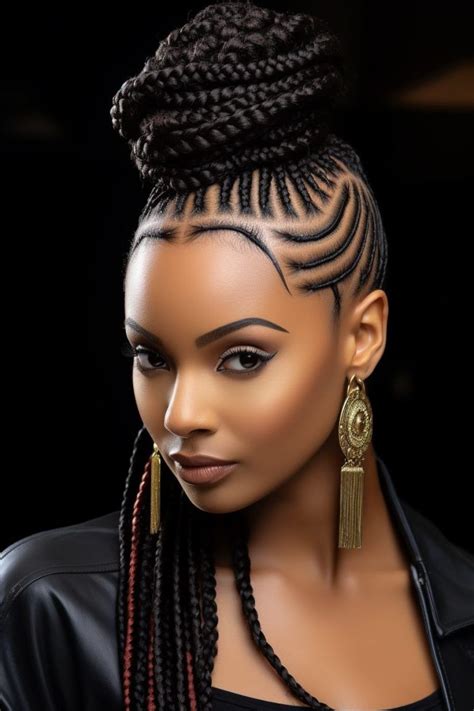Braiding History: A Tapestry of Time
Braid hair has graced the heads of women and girls for centuries, spanning diverse cultures and eras. Historians trace its origins to ancient Egypt, where elaborate braids adorned the pharaohs. In Africa, intricate cornrows and box braids symbolized social status and spirituality. From the Renaissance to the Victorian era, European women wore elaborate coiffures featuring braids, buns, and curls.

Types of Braids: A World of Versatility
The world of braids is vast, with countless variations to suit every taste and hair type. Here are a few popular styles:
- French Braid: A classic three-strand braid with an elegant, intricate look.
- Dutch Braid: Similar to the French braid, but the strands are pulled under, creating a more raised effect.
- Fishtail Braid: Also known as the mermaid braid, this technique involves interlacing small strands of hair, resulting in a delicate, fish-scale pattern.
- Box Braid: A protective style consisting of square-shaped sections of hair that are braided tightly to the scalp.
- Cornrow Braid: A type of box braid that is braided in rows close to the scalp, often with added hair strands for length or volume.
Benefits of Braiding: Beyond Beauty
Beyond their aesthetic appeal, braids offer several practical benefits:
- Hair Protection: Braids shield hair from damage caused by heat styling, brushing, and environmental factors.
- Reduced Frizz: The tight weaving of braids smooths hair strands, reducing frizz and tangles.
- Natural Hair Growth: By keeping hair in a protected and low-maintenance state, braids can promote hair growth and reduce breakage.
- Convenience: Braids are a time-saving and versatile hairstyle that can be worn for days or even weeks.
The Psychology of Braids: Expression and Identity
Braids have long been used as a form of self-expression and cultural identity. In African American culture, braids are a symbol of heritage, strength, and resilience. In some indigenous cultures, braids signify spirituality, connection to the earth, and coming-of-age rituals.
Braiding Techniques: A Masterclass in Style
Mastering braiding techniques takes time and practice. Here’s a step-by-step guide to two classic braids:
French Braid
- Gather a small section of hair from the crown.
- Divide the section into three strands (left, right, center).
- Cross the left strand over the center strand.
- Cross the right strand over the new center strand.
- Repeat steps 3-4, adding small sections of hair from the sides as you go.
- Continue braiding until you reach the ends of your hair.
- Secure with an elastic band.
Fishtail Braid
- Divide your hair into two equal sections (left and right).
- From the outer edge of the left section, take a small strand and cross it over to the inside of the right section.
- Repeat step 2 from the outer edge of the right section, crossing a strand to the inside of the left section.
- Continue alternating sides, crossing small strands from each section to the opposite side.
- Braid until you reach the ends of your hair.
- Secure with an elastic band.
Innovative Braid Applications: Beyond Fashion
Braids have inspired countless applications beyond traditional hairstyling:
- Biomedical Engineering: Scientists are developing braided scaffolds for tissue regeneration and wound healing.
- Fashion Design: Braided textiles are gaining popularity in clothing, accessories, and home décor.
- Architecture: Braided structures are being explored for their strength and flexibility in building design.
- Robotics: Researchers are using braids to create soft, flexible robotic arms with improved dexterity.
Table 1: Braiding Stats for Different Hair Types
| Hair Type | Average Number of Braids | Average Braid Size (inches) |
|---|---|---|
| Straight | 10-15 | 0.5-1 |
| Wavy | 8-12 | 1-1.5 |
| Curly | 6-10 | 1.5-2 |
| Coily | 4-8 | 2-3 |
Table 2: Benefits of Braids for Natural Hair
| Benefit | Description |
|---|---|
| Reduces breakage | Protects hair from friction and tangles |
| Promotes growth | Keeps hair in a protected, low-maintenance state |
| Minimizes frizz | Smooths hair strands and prevents flyaways |
| Enhances curl definition | Helps maintain natural curl patterns |
| Versatile styling option | Can be worn in various styles, from buns to ponytails |
Table 3: Tips and Tricks for Effortless Braiding
- Use a brush or comb to detangle hair before braiding.
- Apply a small amount of hairspray or mousse for better hold.
- Start braiding from the top of your head to prevent tangles.
- Keep the strands taut while braiding, but avoid pulling too tightly.
- Use a mirror to ensure evenness and symmetry.
- Experiment with different braiding patterns and accessories to create unique looks.
Table 4: FAQs About Braids
Q: How often should I wash my hair if it’s braided?
A: Wash your hair once a week or as needed to remove dirt and product buildup.
Q: Can braids cause hair loss?
A: Tight braiding or keeping braids in for too long can lead to traction alopecia, a type of hair loss caused by pulling on the hair follicles.
Q: How long can I keep my braids in?
A: Most braids can be kept in for 2-4 weeks. Protective styles like box braids or cornrows can last longer, up to 6-8 weeks.
Q: Can I braid my hair if it’s short?
A: Yes, there are many braid styles suitable for short hair, such as micro braids, halo braids, and headband braids.
